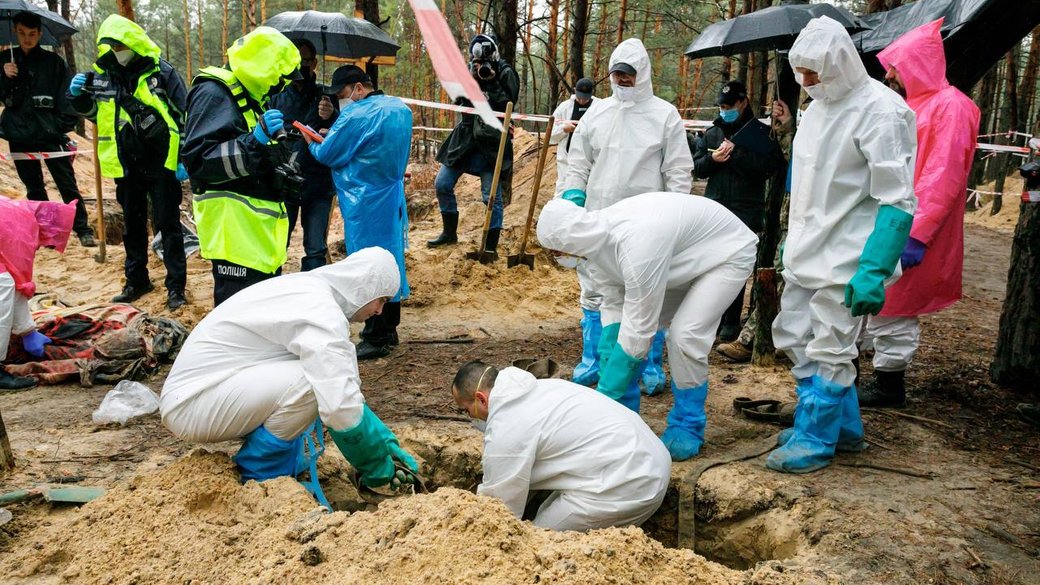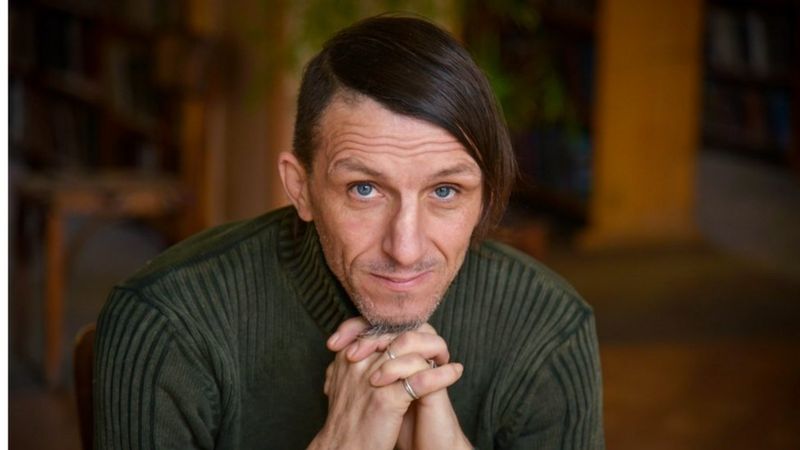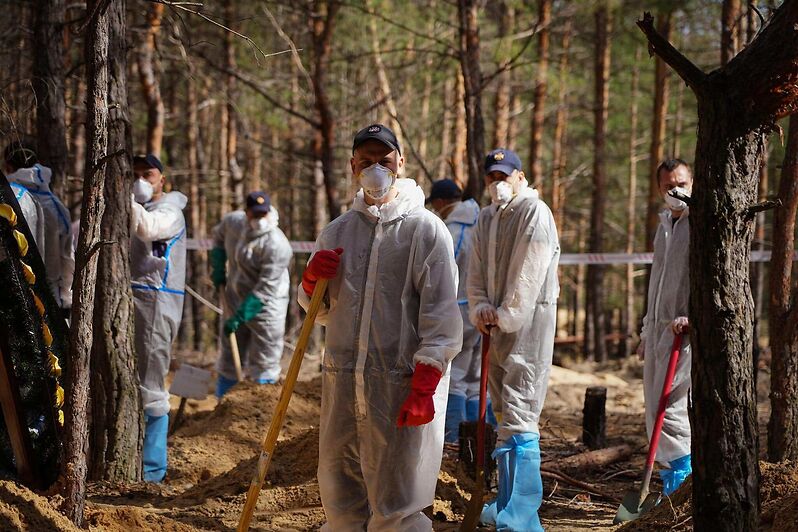57 bodies from Izium mass grave still unidentified

Law-enforcement agencies are still unable to identify 57 of the bodies found in a mass burial on the outskirts of Izium, a town in the Kharkiv Region, announced Dmytro Chubenko on behalf of the Kharkiv Region Prosecutor’s Office.
The identities of a further 58 people, whose remains are buried there, have been established by verifying documentary evidence but it was impossible to carry out a DNA analysis because no relatives of the dead could be found. Chubenko added that more than twenty of the corpses were damaged, with broken bones and 15 displayed signs of torture:
“Expert examination of the exhumed bodies showed that 15 had suffered gunshot wounds, 87 were damaged by explosions and at least 15 revealed signs of torture (their hands were tied, ropes were fastened around their necks); another 23 had broken jaws, skull fractures, broken arms and ribs.”
During their investigation law-enforcement officers had examined the site more than one hundred times, said Chubenko. More than 450 expert tests had been conducted to establish the cause of death, the presence of various bodily wounds and of various distinctive features that could aid in the identification of the bodies.
The mass grave near Izium
In September last year, after the town of Izium was liberated, law-enforcement officers discovered a mass grave in a nearby wooded area. Investigators managed to exhume 451 bodies: 198 male civilians, 212 women, seven children and 22 soldiers.
Watch the T4P video filmed at the burial site
In December 2022, DNA testing confirmed that the body of children’s writer Volodymyr Vakulenko was among those buried in the mass grave.

At the end of December 2022, it became known that Oleh Yefimenko, leader of Plast, the patriotic youth organisation in Izium, was also buried there. Expert examination of his corpse confirmed that he had been tortured.

In both cases the Russian invaders seized the men from their homes. Yefimenko was picked up as a pro-Ukrainian activist and thereafter recorded as missing. On 28 December 2022, his wife was informed that he had been tortured to death.
Izium deputy mayor Volodymyr Matsokin commented in September 2022 that the town became a centre of mass terror where the Russians tormented each and every one of its inhabitants: “some were tortured, some subjected to psychological pressure, others were detained. There were thousands of such cases,” he added.
In an interview with journalists from the Deutsche Welle media company, KHPG director Yevhen Zakharov said that when the Kharkiv Region was liberated it became clear that more than half of those recorded as missing, including forced civilian disappearances, came from the Kharkiv Region. In the T4P database 4,179 were recorded as missing, including under-age victims: the Kharkiv Region accounted for 2,176 of that total, including 88 children.
Identified and unidentified
In December 2022, law enforcement agencies exhumed 899 bodies across the entire Kharkiv Region.
“We’ve never seen so many corpses,” Serhii Bolvinov, head of the Region’s police investigations department, told BBC journalists. “We were digging up ten a day, on average. And the work doesn’t end there. It’s very complicated, of course.”

There were several reasons, experts explained, why it was proving hard to identify the bodies.
Many specialists had left the Kharkiv Region because of the fighting there, and it took time to train up new people. Only eight staff members remained in the laboratory, staff member Viktoriia told us, and they were under enormous pressure.
The lack of electricity in 2022 also slowed down the identification process. “High-precision equipment would suddenly stop working and we were forced to start again from the beginning,” Viktoriia said. Generators did not resolve the problem since there were districts left without any electric light for days on end.
Work was further complicated, as BBC journalists noted, because many bodies were severely burnt. “Genetic material hardly survives when burn injuries are extensive,” explained Oleh Podorozhnyi, a forensic expert. “We send away bone fragments but sometimes experts cannot extract genetic samples from them and ask us to supply something more. That’s why it all moves so slowly.”
And as experts noted last year, not all those who were killed left close relations who could provide comparative genetic material. Many, after all, had left Ukraine.
Even after active hostilities have ended, notes Matthew Holliday, head of the European Programmes of the International Commission on Missing Persons (and the ICMP‘s programme in Ukraine), Ukraine will spend years investigating disappearances that occurred during the present conflict. It will be extremely hard to determine how many of those people survived and how many mass burials are still to be discovered. In view of these difficulties, ICMP specialists have expressed their readiness to help Ukraine to investigate complex cases.
“Assuming the population of missing in Ukraine is 30,000 and growing, this will require collecting and processing at least 90,000 family reference samples during the next several years”, commented the ICMP last year “and collecting and processing upwards of 30,000 post-mortem samples from every missing person, including cases that were already closed through non-scientific means.” High-precision DNA laboratories will enable the identity of the deceased in the most complex conditions, said the ICMP, even when bone samples have degraded.
In August 2022, ICMP director general Kathryne Bomberger said that the Commission could “collect family reference samples inside Ukraine and in … other countries hosting large numbers of Ukrainian refugees”.